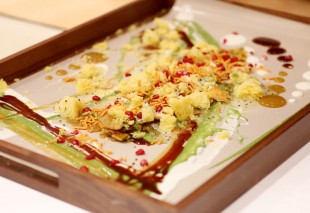

Cuisine Focus 2015: Indian

How popular is Indian cuisine in the Middle East?
Wassim Issa, food & beverage manager, Maharaja by Vineet, Mövenpick Hotel Al Khobar: The Indian culinary scene is popular due to the large influx of Indian expatriates in these countries.
Bhupender Nath, CEO and owner, Tresind: Indian food over the decades has travelled far and wide, and is available at most international destinations and the Middle East is one of them. Also the UAE has an estimated population of two million Indians — 42% of the total UAE population.
Jitin Joshi, executive chef, Taj Dubai: Indian cuisine is not only popular in the Middle East, but globally well established. In the Middle East, one can discover a lot of common ground in the cultures and cuisines. Turkish, Lebanese, Emirati have many ingredients that connect them to the Indian subcontinent; probably owing to the Spice Trail or the Silk Route that runs through the region.
Are there any trends in Indian cuisine you are seeing emerge? What are they?
Feroz Khan, head chef, Claypot: Indian street food, also referred to as ‘chaat’, has always been popular among Dubai residents, nationality notwithstanding. There are so many different dishes to try and a variety of flavours to experience.
Vishal Rane, head chef, La Porte des Indes: There has been an increased focus on healthy food and this can be seen across all cuisines. Indian cuisine is not conventionally associated with health and wellness, but chefs today are working on creating dishes that strike the balance between being healthy and flavourful.
Joshi: “Evolved gastronomy” as I call it; has made its way into Indian dining scene; these restaurants are definitely standing out and making waves. Creativity, deconstructing and reconstructing is a trend which is here to stay.
Gaurav Singh, brand chef, Zafran Dubai: The recent trend in the UAE is molecular gastronomy which has been used as a tool to present the food in a different and modern way. This is a very interesting and a newer form of presentation as it presents Indian food in different textures.
Nath: Amongst the oldest in the world, Indian cuisine is known for its taste and texture using traditional forms of cooking. But with the passage of time, various new cooking methods, techniques and styles have been incorporated.
Many guests as well as industry professionals have commented that it is hard to find “fine dining” Indian restaurants that are popular...
Khan: I do agree that it is difficult to find and stick to an ‘Indian fine dining’ venue that ticks all the boxes; however this is not because of the lack of Indian fine dining venues in the market. Dubai’s food and beverage scene is constantly growing; people like to try new things and therefore rarely visit one outlet that often.
Joshi: Fine dining restaurants, are institutions where you do not dine in every day. There has to be a charm factor and creating a memory out of the experience. Most people walk into fine dining restaurants with a set expectation and it should not be that way. The chefs too take a safer route in offering the norm and are client-driven.
Do you face any challenges when it comes to Indian food?
Khan: Competition in Dubai for restaurants and, specifically in Bur Dubai and the surrounding areas is fierce. The price factor in this area is definitely an important topic.
Rane: In Dubai, the competition among Indian restaurants is extremely stiff. There are several options to suit every price bracket. You find restaurants that focus on Indian cuisine originating from a particular region, while others offer the best of everything or cuisine with a ‘strong Indian influence’. There are too many options and as a result, diners are spoilt for choice.
Issa: A number of new restaurants, catering to different sets of clientele is emerging, and competition is there. At Maharaja by Vineet, the challenge of being in a competitive environment is relatively small. Our signature, fine-dining restaurant is unique, as it is the only Indian restaurant in Saudi Arabia by a Michelin-starred Indian chef.
Joshi: “Expectations from the native Indians” — I could write a book on that! However, as a generalisation, most Indians dine out to quench their hunger and leave satiated with meaningful, memorable tastes that they can relate to; rather than an inquisitive diner who is exploring newer realms and cuisines. As a chef we have to be mindful of creating a bridge between creativity and acceptability.
Any advantages of serving this specific market?
Khan: Dubai is a well-known trade route within the Middle East; therefore it is quite easy to find specific ingredients. The spices, meat and fish markets have an array of products and are well-stocked. Having a large Indian community with shops catering specifically to Indians helps greatly as items are specially flown in for the consumption of UAE’s Indian residents.
Issa: The Middle East, with its close proximity to India, not only makes hiring skilled chefs who know the right cooking techniques an easier task, but also makes sourcing of authentic ingredients and spices effortless.